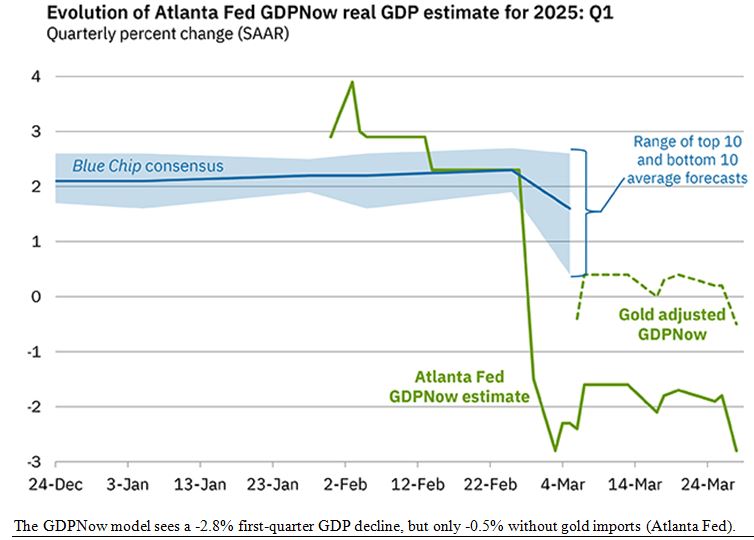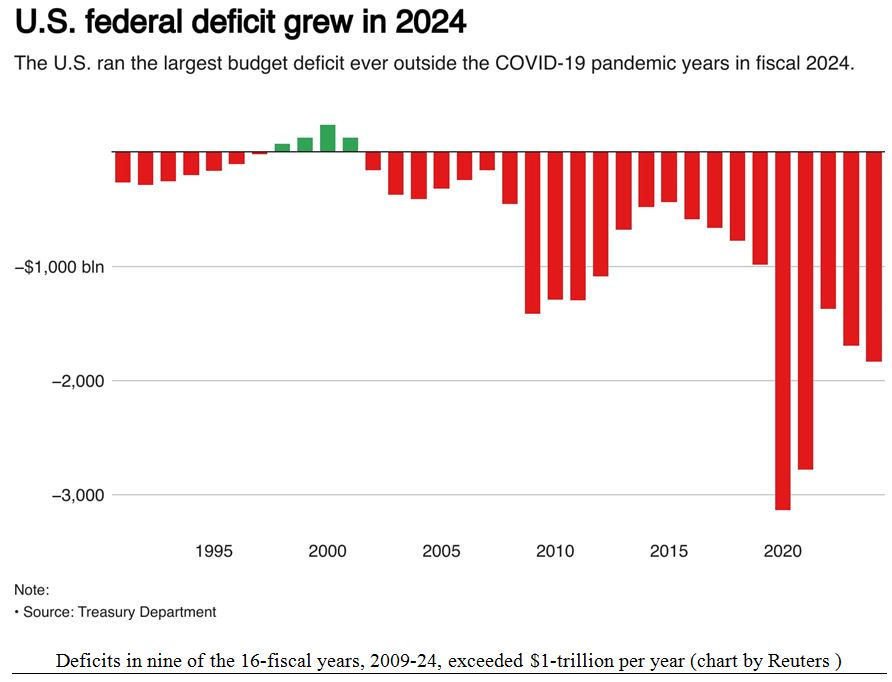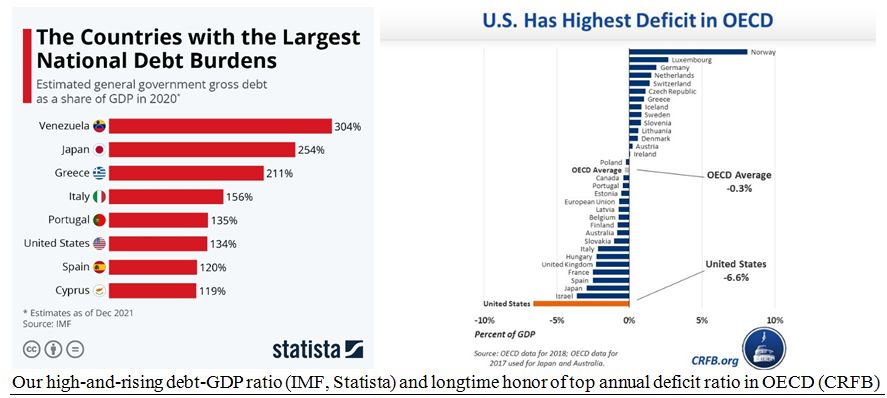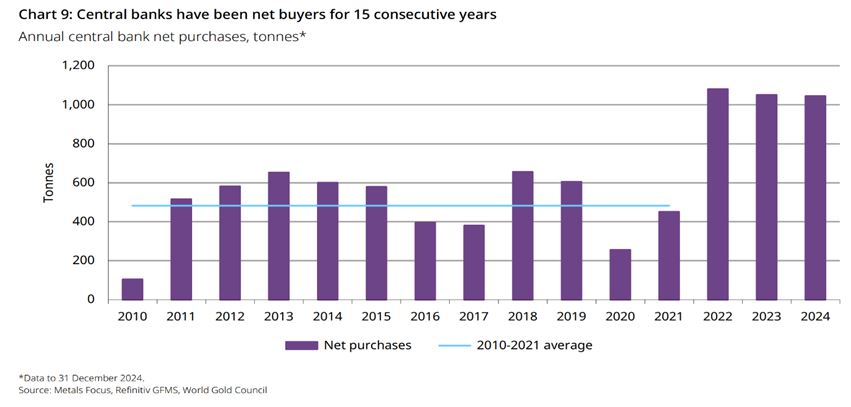by Gary Alexander
April 1, 2025
The first quarter is officially over. At press time, I don’t have Monday’s final figures to report, but as of Friday’s close, gold and silver are up 17% and 20%, respectively, year-to-date, while all the stock indexes are down. March divided gold from stocks, with gold up 9%, silver up 11% and stocks down 5% (Dow) to 8% (NASDAQ). The U.S. Dollar Index (DXY) fell 3.3% so far in March, super-charging commodities.
Gold also had the dubious distinction of throwing the U.S. GDP deep into negative territory for the first quarter, due to massive imports. It’s a strange statistical anomaly, having nothing to do with economic production. On March 18 here, I wrote, that the Atlanta Fed’s quick 5-point GDP drop from +2.3% to -2.8% in three business days reflected “a flawed model. It takes human beings to interpret data so they won’t be jerked around by figures that can be easily explained by: (1) exporters dumping their goods before tariffs take effect, plus (2) fires and bad weather.” I was wrong to put blame on the Atlanta Fed.
The Atlanta Fed merely tries to emulate the GDP formula of Bureau of Economic Analysis (BEA), so the blame goes to the BEA. Atlanta Fed economist Pat Higgins wrote, “Much of the widening of the trade deficit in January was due to an increase in non-monetary gold imports from $13.2-billion in December $32.6-billion in January. This accounted for nearly 60-percent of the widening of the goods trade deficit.”
The BEA distinguishes gold from other exports, but Higgins says this distorts the GDP: “Removing gold from imports and exports leads to an increase in both GDPNow’s topline growth forecast and the contribution of net exports to that forecast of about 2-percentage points.” Higgins promised to include a gold-adjusted line from in his model, and he did so on Friday, March 28, as the GDPNow model predicted -2.8% for the quarterly U.S. GDP, while the gold-adjusted GDP was only -0.5%, a 2.3% gap:

Graphs are for illustrative and discussion purposes only. Please read important disclosures at the end of this commentary.
How can the transport of this inert metal, gold, from one port to another cause a 2.3% annualized decline in a $27-trillion economy? GDP means Domestic Production (the DP in GDP), not shifting metal flows.
I’ve read most of the BEA explanation for this – and it still doesn’t make sense to me – but what makes sense is that Americans are demanding more gold in their investment accounts, via exchange traded funds (ETFs) and futures accounts on COMEX, so this his fueled a huge demand for bullion from Britain and Switzerland to back those accounts with physical gold, as required by regulations, hence the import flood.
Gold’s Rise is Mostly Due to Soaring Deficit Since 2001, and Inflation Since 2021
After four budget surpluses (1998-2001), our accumulated national debt was barely $5-trillion in 2001, but it has now reached $36.2-trillion, with an average of over $2-trillion added each year since 2020.

Graphs are for illustrative and discussion purposes only. Please read important disclosures at the end of this commentary.
With our GDP this year expected to be around $27-trillion, and our deficits rising at a pace of $220-billion per month, our accumulated national debt should reach $38-trillion by the end of 2025. That means we will have a debt-to-GDP ratio of 140% (38 divided by 27). Those countries exceeding 150% debt-to-GDP ratio (Venezuela, Japan, Greece and Italy) have not been able to grow their economies much.

Graphs are for illustrative and discussion purposes only. Please read important disclosures at the end of this commentary.
We also have the highest annual budget deficit rate (vs. GDP) of any established, rich (OECD) nation, ranging from 6% to 7% of GDP per year in recent years (right chart, above). It looks like our annual deficit as a percent of GDP will top 7% this year, unless the Trump team works some miracles … fast.
Here’s the math. If we run up $2-trillion in red ink this year, that equals 7.4% of our GDP ($27-trillion). This would virtually tie us with Brazil (7.5%) for the highest rate of any major nation, more than double the euro-zone rate (3.4%) and triple Canada’s rate (2.3%). Some nations in Europe even have budget surpluses, like Denmark, Norway and Switzerland, as do Asian-Tigers Taiwan and Singapore.
Budget deficits show no signs of falling. Both political parties have made a habit of over-spending in the last 24-years. The federal fiscal year of 2025 began October 1, 2024, and although President Trump and Elon Musk’s DOGE team are trying to bring the 2025 budget deficit under $1-trillion, that is a Herculean task, considering the massive level of resistance they are encountering in Washington DC and nationwide.
As a case in point, the federal deficit grew by $308-billion in February 2025, President Trump’s first full month in office. That means the cumulative federal deficit for the first five-months of fiscal year 2025 reached $1.1-trillion (a $2.64-trillion annual rate). Even after adjusting for the timing shift of certain payments, the current-year deficit is 18% larger than the same five months of fiscal year 2024. Spending was $41-billion higher (+11%) this February over last February, and this includes $5-billion less spending in the beleaguered Department of Education, the first major target of the DOGE team of cost cutters.
For the first five-months of the new fiscal year, spending rose by $200-billion (+7%), most of it out of the Trump team’s control, including +$73-billion for cost-of-living increases in Social Security and related Medicare and Medicaid increases, and +$44-billion for interest on the national debt. Most of the rest was from disaster relief and EPA grants. To pay for that new spending, tax receipts grew by only $37-billion.
America desperately needs to get its spending juggernaut under control, despite the violent resistance from the entrenched entitlement community. Gold reflects our inability to do that. Soaring deficits of the financial crises of 2001 to 2011 sent gold up from $260 to $1,500. After a pause, gold began a second rise to $3,000, also on soaring debts, this time with an inflation kicker. In all, gold has soared over three times faster than stocks over the last 25-years, and silver has doubled stock index gains in the last 25-years:

Since 2020, gold has doubled in the last five years from $1,500 to over $3,000, while the Dow is up under 50% and the S&P 500 is up less than 80%. Gold is clearly bursting its suspenders in pride, but you won’t find any coverage of this story on Page 1 of a financial journal or financial news channels. And that’s just fine with me. If the press were all over the gold story, I would be concerned over a bubble about to pop.
Central Banks Have Quietly Resumed a New “Shadow Gold-Standard”
There’s one more story to tell. Before 2022, central banks seldom bought more than 600-tonnes per year (a tonne, or metric ton, is equal to 2,205-pounds or 32,150-Troy ounces) of gold, but in 2022, the world’s central banks started buying over 1,000-tonnes per year, continuing at that same rate in 2025, creating a quiet new “gold-standard,” exchanging their paper currencies in favor of the metal which has triumphed over all paper currencies over time, the metal that gave birth to the original gold-standard that funded the industrial revolutions of Great Britain and the United States in the late 18th through early 20th centuries.

Graphs are for illustrative and discussion purposes only. Please read important disclosures at the end of this commentary.
Chart from KITCO News, February 2025
As this chart from KITCO shows, central bank demand in the last three years doubled the blue line of the previous average of just under 500-tonnes per year, reflecting their response to deficits and high inflation in several currencies, with no major paper currency emerging to challenge the ever-weaker U.S. dollar.
We are a stock-oriented letter – and we should maintain the majority of our assets in good stocks – but for portfolio balance, gold is a currency alternative and (for some) also possibly a bond alternative as well.
All content above represents the opinion of Gary Alexander of Navellier & Associates, Inc.
Also In This Issue
A Look Ahead by Louis Navellier
Trade Talks Escalate as “Liberation Day” Approaches
Income Mail by Bryan Perry
Follow the Money Flows into Stagflation-Proof Assets
Growth Mail by Gary Alexander
Gold is Quietly Dominating the Financial World…Once Again
Global Mail by Ivan Martchev
Beware of the Auto Tariff Quicksand
Sector Spotlight by Jason Bodner
Did Margin Debt Fuel This March Market Madness?
View Full Archive
Read Past Issues Here
About The Author

Gary Alexander
SENIOR EDITOR
Gary Alexander has been Senior Writer at Navellier since 2009. He edits Navellier’s weekly Marketmail and writes a weekly Growth Mail column, in which he uses market history to support the case for growth stocks. For the previous 20-years before joining Navellier, he was Senior Executive Editor at InvestorPlace Media (formerly Phillips Publishing), where he worked with several leading investment analysts, including Louis Navellier (since 1997), helping launch Louis Navellier’s Blue Chip Growth and Global Growth newsletters.
Prior to that, Gary edited Wealth Magazine and Gold Newsletter and wrote various investment research reports for Jefferson Financial in New Orleans in the 1980s. He began his financial newsletter career with KCI Communications in 1980, where he served as consulting editor for Personal Finance newsletter while serving as general manager of KCI’s Alexandria House book division. Before that, he covered the economics beat for news magazines. All content of “Growth Mail” represents the opinion of Gary Alexander
Important Disclosures:
Although information in these reports has been obtained from and is based upon sources that Navellier believes to be reliable, Navellier does not guarantee its accuracy and it may be incomplete or condensed. All opinions and estimates constitute Navellier’s judgment as of the date the report was created and are subject to change without notice. These reports are for informational purposes only and are not a solicitation for the purchase or sale of a security. Any decision to purchase securities mentioned in these reports must take into account existing public information on such securities or any registered prospectus.To the extent permitted by law, neither Navellier & Associates, Inc., nor any of its affiliates, agents, or service providers assumes any liability or responsibility nor owes any duty of care for any consequences of any person acting or refraining to act in reliance on the information contained in this communication or for any decision based on it.
Past performance is no indication of future results. Investment in securities involves significant risk and has the potential for partial or complete loss of funds invested. It should not be assumed that any securities recommendations made by Navellier. in the future will be profitable or equal the performance of securities made in this report. Dividend payments are not guaranteed. The amount of a dividend payment, if any, can vary over time and issuers may reduce dividends paid on securities in the event of a recession or adverse event affecting a specific industry or issuer.
None of the stock information, data, and company information presented herein constitutes a recommendation by Navellier or a solicitation to buy or sell any securities. Any specific securities identified and described do not represent all of the securities purchased, sold, or recommended for advisory clients. The holdings identified do not represent all of the securities purchased, sold, or recommended for advisory clients and the reader should not assume that investments in the securities identified and discussed were or will be profitable.
Information presented is general information that does not take into account your individual circumstances, financial situation, or needs, nor does it present a personalized recommendation to you. Individual stocks presented may not be suitable for every investor. Investment in securities involves significant risk and has the potential for partial or complete loss of funds invested. Investment in fixed income securities has the potential for the investment return and principal value of an investment to fluctuate so that an investor’s holdings, when redeemed, may be worth less than their original cost.
One cannot invest directly in an index. Index is unmanaged and index performance does not reflect deduction of fees, expenses, or taxes. Presentation of Index data does not reflect a belief by Navellier that any stock index constitutes an investment alternative to any Navellier equity strategy or is necessarily comparable to such strategies. Among the most important differences between the Indices and Navellier strategies are that the Navellier equity strategies may (1) incur material management fees, (2) concentrate its investments in relatively few stocks, industries, or sectors, (3) have significantly greater trading activity and related costs, and (4) be significantly more or less volatile than the Indices.
ETF Risk: We may invest in exchange traded funds (“ETFs”) and some of our investment strategies are generally fully invested in ETFs. Like traditional mutual funds, ETFs charge asset-based fees, but they generally do not charge initial sales charges or redemption fees and investors typically pay only customary brokerage fees to buy and sell ETF shares. The fees and costs charged by ETFs held in client accounts will not be deducted from the compensation the client pays Navellier. ETF prices can fluctuate up or down, and a client account could lose money investing in an ETF if the prices of the securities owned by the ETF go down. ETFs are subject to additional risks:
- ETF shares may trade above or below their net asset value;
- An active trading market for an ETF’s shares may not develop or be maintained;
- The value of an ETF may be more volatile than the underlying portfolio of securities the ETF is designed to track;
- The cost of owning shares of the ETF may exceed those a client would incur by directly investing in the underlying securities; and
- Trading of an ETF’s shares may be halted if the listing exchange’s officials deem it appropriate, the shares are delisted from the exchange, or the activation of market-wide “circuit breakers” (which are tied to large decreases in stock prices) halts stock trading generally.
Grader Disclosures: Investment in equity strategies involves substantial risk and has the potential for partial or complete loss of funds invested. The sample portfolio and any accompanying charts are for informational purposes only and are not to be construed as a solicitation to buy or sell any financial instrument and should not be relied upon as the sole factor in an investment making decision. As a matter of normal and important disclosures to you, as a potential investor, please consider the following: The performance presented is not based on any actual securities trading, portfolio, or accounts, and the reported performance of the A, B, C, D, and F portfolios (collectively the “model portfolios”) should be considered mere “paper” or pro forma performance results based on Navellier’s research.
Investors evaluating any of Navellier & Associates, Inc.’s, (or its affiliates’) Investment Products must not use any information presented here, including the performance figures of the model portfolios, in their evaluation of any Navellier Investment Products. Navellier Investment Products include the firm’s mutual funds and managed accounts. The model portfolios, charts, and other information presented do not represent actual funded trades and are not actual funded portfolios. There are material differences between Navellier Investment Products’ portfolios and the model portfolios, research, and performance figures presented here. The model portfolios and the research results (1) may contain stocks or ETFs that are illiquid and difficult to trade; (2) may contain stock or ETF holdings materially different from actual funded Navellier Investment Product portfolios; (3) include the reinvestment of all dividends and other earnings, estimated trading costs, commissions, or management fees; and, (4) may not reflect prices obtained in an actual funded Navellier Investment Product portfolio. For these and other reasons, the reported performances of model portfolios do not reflect the performance results of Navellier’s actually funded and traded Investment Products. In most cases, Navellier’s Investment Products have materially lower performance results than the performances of the model portfolios presented.
This report contains statements that are, or may be considered to be, forward-looking statements. All statements that are not historical facts, including statements about our beliefs or expectations, are “forward-looking statements” within the meaning of The U.S. Private Securities Litigation Reform Act of 1995. These statements may be identified by such forward-looking terminology as “expect,” “estimate,” “plan,” “intend,” “believe,” “anticipate,” “may,” “will,” “should,” “could,” “continue,” “project,” or similar statements or variations of such terms. Our forward-looking statements are based on a series of expectations, assumptions, and projections, are not guarantees of future results or performance, and involve substantial risks and uncertainty as described in Form ADV Part 2A of our filing with the Securities and Exchange Commission (SEC), which is available at www.adviserinfo.sec.gov or by requesting a copy by emailing info@navellier.com. All of our forward-looking statements are as of the date of this report only. We can give no assurance that such expectations or forward-looking statements will prove to be correct. Actual results may differ materially. You are urged to carefully consider all such factors.
FEDERAL TAX ADVICE DISCLAIMER: As required by U.S. Treasury Regulations, you are informed that, to the extent this presentation includes any federal tax advice, the presentation is not written by Navellier to be used, and cannot be used, for the purpose of avoiding federal tax penalties. Navellier does not advise on any income tax requirements or issues. Use of any information presented by Navellier is for general information only and does not represent tax advice either express or implied. You are encouraged to seek professional tax advice for income tax questions and assistance.
IMPORTANT NEWSLETTER DISCLOSURE:The hypothetical performance results for investment newsletters that are authored or edited by Louis Navellier, including Louis Navellier’s Growth Investor, Louis Navellier’s Breakthrough Stocks, Louis Navellier’s Accelerated Profits, and Louis Navellier’s Platinum Club, are not based on any actual securities trading, portfolio, or accounts, and the newsletters’ reported hypothetical performances should be considered mere “paper” or proforma hypothetical performance results and are not actual performance of real world trades. Navellier & Associates, Inc. does not have any relation to or affiliation with the owner of these newsletters. There are material differences between Navellier Investment Products’ portfolios and the InvestorPlace Media, LLC newsletter portfolios authored by Louis Navellier. The InvestorPlace Media, LLC newsletters contain hypothetical performance that do not include transaction costs, advisory fees, or other fees a client might incur if actual investments and trades were being made by an investor. As a result, newsletter performance should not be used to evaluate Navellier Investment services which are separate and different from the newsletters. The owner of the newsletters is InvestorPlace Media, LLC and any questions concerning the newsletters, including any newsletter advertising or hypothetical Newsletter performance claims, (which are calculated solely by Investor Place Media and not Navellier) should be referred to InvestorPlace Media, LLC at (800) 718-8289.
Please note that Navellier & Associates and the Navellier Private Client Group are managed completely independent of the newsletters owned and published by InvestorPlace Media, LLC and written and edited by Louis Navellier, and investment performance of the newsletters should in no way be considered indicative of potential future investment performance for any Navellier & Associates separately managed account portfolio. Potential investors should consult with their financial advisor before investing in any Navellier Investment Product.
Navellier claims compliance with Global Investment Performance Standards (GIPS). To receive a complete list and descriptions of Navellier’s composites and/or a presentation that adheres to the GIPS standards, please contact Navellier or click here. It should not be assumed that any securities recommendations made by Navellier & Associates, Inc. in the future will be profitable or equal the performance of securities made in this report.
FactSet Disclosure: Navellier does not independently calculate the statistical information included in the attached report. The calculation and the information are provided by FactSet, a company not related to Navellier. Although information contained in the report has been obtained from FactSet and is based on sources Navellier believes to be reliable, Navellier does not guarantee its accuracy, and it may be incomplete or condensed. The report and the related FactSet sourced information are provided on an “as is” basis. The user assumes the entire risk of any use made of this information. Investors should consider the report as only a single factor in making their investment decision. The report is for informational purposes only and is not intended as an offer or solicitation for the purchase or sale of a security. FactSet sourced information is the exclusive property of FactSet. Without prior written permission of FactSet, this information may not be reproduced, disseminated or used to create any financial products. All indices are unmanaged and performance of the indices include reinvestment of dividends and interest income, unless otherwise noted, are not illustrative of any particular investment and an investment cannot be made in any index. Past performance is no guarantee of future results.
